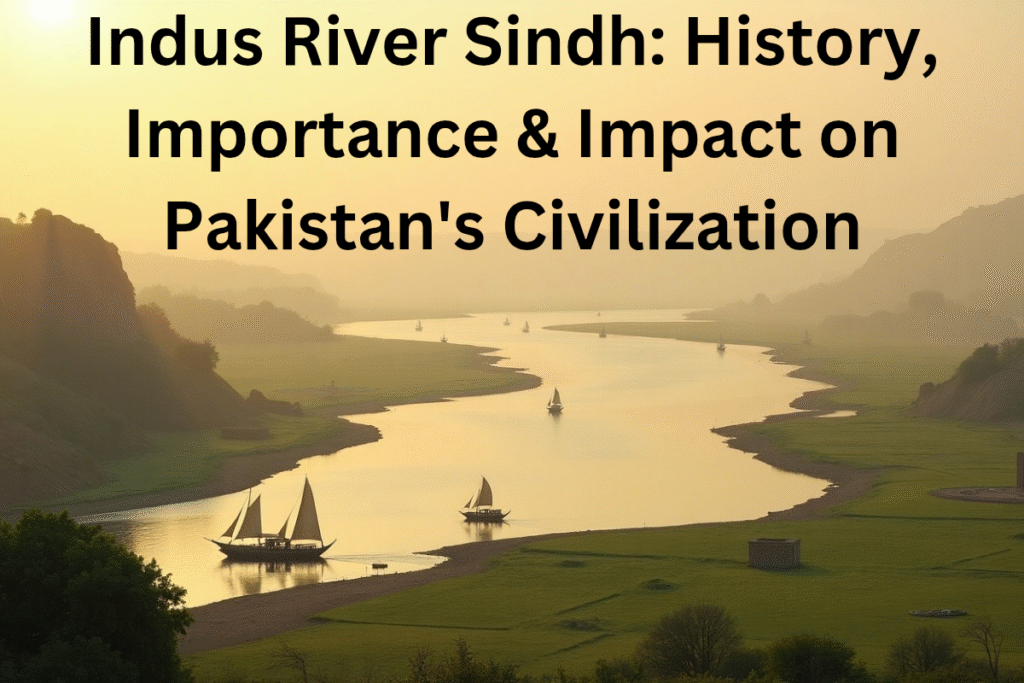Overview to the Indus River Sindh
The Indus River, locally known as “Sindhu,” is not just a water body—it is the lifeblood of Pakistan, especially the Sindh province. This majestic river has shaped civilizations, sustained livelihoods, and served as a cultural and economic cornerstone for millennia. Stretching over 3,180 kilometers (1,976 miles), the Indus originates in Tibet and flows through Ladakh, Gilgit-Baltistan, Punjab, and Sindh, before emptying into the Arabian Sea.
In Sindh, the river becomes particularly crucial, irrigating the arid plains and supporting one of the oldest settled civilizations in human history.
The Origin and Course of the Indus River
H2: Where Does the Indus River Begin and End?
The Indus River originates near Lake Mansarovar in Tibet, flowing through the Himalayas and into the Karakoram Range. It then makes its way southward into Pakistan via Skardu and Gilgit-Baltistan, eventually descending into the Punjab and Sindh plains, where it spreads life across fertile agricultural lands.
H3: The Indus in Sindh
Upon entering Sindh, the river slows down, forming distributaries and deltaic systems. The Indus Delta, stretching near Thatta, is one of the largest arid deltas in the world and home to unique biodiversity, including mangrove forests and aquatic life.
Historical Significance: Cradle of the Indus Valley Civilization
H2: What Was the Indus Valley Civilization?
Over 5,000 years ago, the Indus River supported the flourishing Indus Valley Civilization (IVC)—one of the world’s earliest urban cultures. Major sites like Mohenjo-Daro and Harappa were situated along the riverbanks, showcasing advanced urban planning, sanitation, and trade networks.
H3: Mohenjo-Daro – A UNESCO World Heritage Site
Located near Larkana in Sindh, Mohenjo-Daro is one of the most significant archaeological finds. The city’s grid-like layout, advanced drainage system, and granaries highlight the engineering prowess of ancient Indus inhabitants.
The Indus River in Sindh Today
Today, the Indus River continues to be vital for Sindh’s economy and agriculture. It flows through major cities like Sukkur, Hyderabad, and near Karachi, playing a key role in irrigation and energy production.
H3: Sukkur Barrage – Engineering Marvel
The Sukkur Barrage, built during British colonial rule in the early 20th century, is one of the largest irrigation systems in the world. It diverts water into canals that irrigate millions of acres in Sindh.
Agricultural and Economic Importance
H2: How Does the Indus Support Sindh’s Agriculture?
The Indus provides over 90% of irrigation in Sindh. Major crops like wheat, rice, sugarcane, and cotton depend on its waters. Without it, Sindh’s arid climate would make large-scale agriculture nearly impossible.
H3: Contribution to Pakistan’s GDP
- Agriculture: Contributes over 19% to Pakistan’s GDP, most of it dependent on the Indus.
- Fishing: The river supports a thriving fisheries industry, especially near the delta.
- Hydropower: Dams and barrages on the Indus generate significant electricity, essential for Pakistan’s energy security.
Environmental Challenges Facing the Indus
H2: What Threatens the Indus River in Sindh?
Despite its importance, the Indus is under serious threat from climate change, pollution, over-extraction, and dams upstream.
H3: Climate Change and Glacial Melting
Since the river’s flow originates from glacial melt, rising global temperatures threaten to disrupt seasonal flows, risking both floods and droughts.
H3: Pollution and Industrial Waste
Unregulated dumping of sewage and industrial waste into the river is degrading water quality, affecting human health and ecosystems.
Cultural and Religious Relevance
H2: What Is the Spiritual Significance of the Indus?
Historically, the Indus has been revered in Hindu scriptures as a sacred river, and its name forms the root of the word “India.” In modern times, the river continues to symbolize cultural unity and identity, especially for the Sindhi people.
H3: Folk Songs and Traditions
The Indus is often referenced in Sindhi folklore, poetry, and music, reflecting its place in cultural consciousness. From ancient Vedic hymns to Sufi poetry, the river has inspired generations.
Conservation Efforts and Sustainable Development
H2: How Is the Indus Being Protected?
Governments, NGOs, and international bodies have begun initiating restoration and conservation projects, including:
- Indus River System Authority (IRSA): Manages water distribution among provinces.
- Mangrove Restoration Projects in the Indus Delta.
- Awareness Campaigns promoting sustainable water usage.
H3: Eco-Tourism and Education
Promoting eco-tourism, particularly around Mohenjo-Daro and the delta, could provide incentives for conservation while boosting local economies.
Frequently Asked Questions (FAQs)
Q1: Where does the Indus River start and end?
The Indus River starts in Tibet near Lake Mansarovar and ends in Sindh, Pakistan, where it flows into the Arabian Sea.
Q2: What is the historical importance of the Indus River in Sindh?
It supported the Indus Valley Civilization, one of the world’s oldest civilizations, and was home to Mohenjo-Daro, a UNESCO World Heritage site.
Q3: How does the Indus benefit Sindh today?
It provides irrigation, supports farming, powers hydroelectric plants, and sustains biodiversity in the region.
Q4: What are the main threats to the Indus River in Sindh?
Climate change, pollution, over-extraction, and upstream damming are the major threats affecting the river’s flow and quality.
Q5: What can be done to save the Indus River?
Conservation, sustainable water use, pollution control, public awareness, and international cooperation are essential for saving the river.
Final Thoughts
The Indus River in Sindh is more than a water source—it’s a symbol of life, history, and resilience. From the rise of one of the world’s oldest civilizations to its role in modern agriculture and culture, the Indus remains central to the identity and survival of Pakistan.
But it’s under threat, and time is running out. Only through collective action—education, conservation, and innovation—can we ensure the Indus continues to flow through the heart of Sindh for generations to come.



